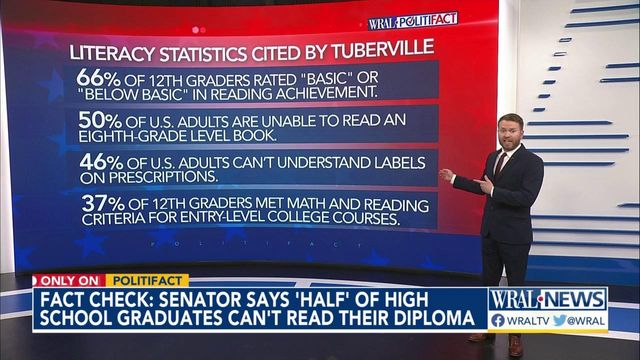Fact check: Tuberville says half of high school graduates 'can't read their diploma'
During a discussion at the annual Conservative Political Action Conference, Sen. Tommy Tuberville, R-Ala., said: "Half the kids in this country, when they graduate, can't read their diploma." PolitiFact checks his claim.
Posted — UpdatedDuring a discussion at the annual Conservative Political Action Conference, Sen. Tommy Tuberville, R-Ala., criticized the educational attainment of the nation’s high schoolers.
"Half the kids in this country, when they graduate, can’t read their diploma," Tuberville said March 2.
When we looked at the data and checked with experts, we found that Tuberville’s claim is exaggerated. The vast majority of high school seniors have the most basic reading skills — what it would take to read a diploma — even if their reading test scores are considered subpar for their grade level.
Statistics on reading skills
When we contacted Tuberville’s office, a spokesperson shared data points the senator was relying on:
- 50% of U.S. adults are unable to read an eighth-grade level book.
- 46% of U.S. adults can’t understand labels on prescriptions.
- 66% of American 12th graders are rated "basic" or "below basic" in reading achievement.
- Only 37% of 12th graders reached or exceeded the academic preparedness benchmarks for both math and reading that would qualify them for entry-level college courses.
Independent experts said several (though not all) of these statistics are accurate — but they added that they don’t directly support Tuberville’s claim, which is more about functional literacy than about educational reading standards.
Timothy Shanahan, founding director of the University of Illinois-Chicago’s Center for Literacy, told PolitiFact he cannot vouch for it. He said the Organization for Economic Cooperation and Development, a Paris-based think tank that has been cited as this statistic’s source, "doesn’t employ grade-level estimates like that, and it would be very hard to provide meaningful ones, which is why they don’t do it."
The statistic on U.S. adults who don’t understand prescription labels, however, "is well in line" with past studies, Shanahan said.
As for the statistic that 66% of American 12th graders are rated "basic" or "below basic" in reading achievement, the Education Department told PolitiFact in a statement that the 2019 figure was 63%, close to Tuberville’s number.
Why these statistics don’t prove Tuberville’s point
So, the statistics Tuberville’s office provided include several figures that are credible and one that is not. But experts said the problem with Tuberville’s claim is that none of these statistics support the idea that recent high school graduates cannot read their diplomas.
Reading a diploma is much less complicated than what the statistics Tuberville’s office cited are measuring. Failing to read at a "basic" 12th grade level doesn’t mean that you can’t read a diploma.
None of those skills would be necessary to read a diploma. Similarly, the inability to navigate an entry-level college course, as one of Tuberville’s cited statistics measured, does not mean that someone cannot read a diploma.
"There is often a fundamental misunderstanding of literacy attainment in the U.S.," Shanahan said. "Historically, illiteracy meant that a person couldn’t even write their own name — in other words, pretty much total illiteracy, no reading or writing ability at all."
But today, Shanahan said, a far smaller percentage than half or recent high school graduates fails to attain "basic literacy levels — the ability to read and understand simple messages. And one would assume a high school diploma would be a simple message."
There are exceptions, he said. These include people with severe sensory or cognitive deficits, and "teens and young adults who come into the U.S. with little schooling in their home countries." However, these wouldn’t fit into Tuberville’s category because "for the most part, these students aren’t attending U.S. schools, or are very briefly, meaning that they are not graduating from our high schools."
Shanahan said Tuberville may have a point that there are "a small number of American graduates who can’t successfully read simple messages. But he is badly mischaracterizing the state of literacy in the U.S."
PolitiFact ruling
Tuberville said, "Half the kids in this country, when they graduate, can’t read their diploma."
Data shows that as many as two-thirds of American high school graduates have underdeveloped reading skills, measured by common standards for their grade level.
But the people in this category are not so functionally illiterate that they cannot read a diploma, which requires far less skill than what grade-level assessments are testing.
Experts say the percentage of young Americans who are truly functionally illiterate is far smaller than 50%.
The statement contains an element of truth but ignores critical facts that would give a different impression. We rate it Mostly False.
Related Topics
Copyright 2024 Politifact. All rights reserved.





